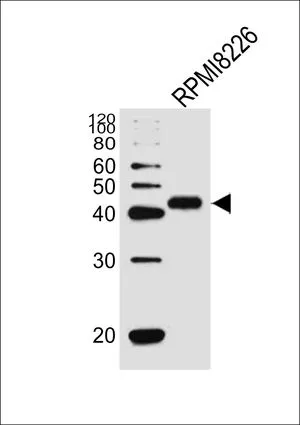
IHC-P analysis of human hepatocarcinoma tissue using GTX81962 CD38 antibody, C-term. Green : CD38 Red : Cell nuclear Dilution : 0.05 mg/ml
CD38 antibody, C-term
GTX81962
ApplicationsFlow Cytometry, ImmunoFluorescence, Western Blot, ImmunoCytoChemistry, ImmunoHistoChemistry, ImmunoHistoChemistry Paraffin
Product group Antibodies
ReactivityHuman
TargetCD38
Overview
- SupplierGeneTex
- Product NameCD38 antibody, C-term
- Delivery Days Customer9
- Application Supplier NoteWB: 1:1000. ICC/IF: 1:10-1:50. IHC-P: 1:50-1:100. FACS: 1:10-1:50. *Optimal dilutions/concentrations should be determined by the researcher.Not tested in other applications.
- ApplicationsFlow Cytometry, ImmunoFluorescence, Western Blot, ImmunoCytoChemistry, ImmunoHistoChemistry, ImmunoHistoChemistry Paraffin
- CertificationResearch Use Only
- ClonalityPolyclonal
- ConjugateUnconjugated
- Gene ID952
- Target nameCD38
- Target descriptionCD38 molecule
- Target synonymsADPRC 1, ADPRC1, cADPR1, ADP-ribosyl cyclase/cyclic ADP-ribose hydrolase 1, 2'-phospho-ADP-ribosyl cyclase, 2'-phospho-cyclic-ADP-ribose transferase, ADP-ribosyl cyclase 1, CD38 antigen (p45), NAD(+) nucleosidase, cluster of differentiation 38, cyclic ADP-ribose hydrolase 1, ecto-nicotinamide adenine dinucleotide glycohydrolase
- HostRabbit
- IsotypeIgG
- Protein IDP28907
- Protein NameADP-ribosyl cyclase/cyclic ADP-ribose hydrolase 1
- Scientific DescriptionThe protein encoded by this gene is a non-lineage-restricted, type II transmembrane glycoprotein that synthesizes and hydrolyzes cyclic adenosine 5-diphosphate-ribose, an intracellular calcium ion mobilizing messenger. The release of soluble protein and the ability of membrane-bound protein to become internalized indicate both extracellular and intracellular functions for the protein. This protein has an N-terminal cytoplasmic tail, a single membrane-spanning domain, and a C-terminal extracellular region with four N-glycosylation sites. Crystal structure analysis demonstrates that the functional molecule is a dimer, with the central portion containing the catalytic site. It is used as a prognostic marker for patients with chronic lymphocytic leukemia. Alternative splicing results in multiple transcript variants. [provided by RefSeq, Sep 2015]
- ReactivityHuman
- Storage Instruction-20°C or -80°C,2°C to 8°C
- UNSPSC12352203











